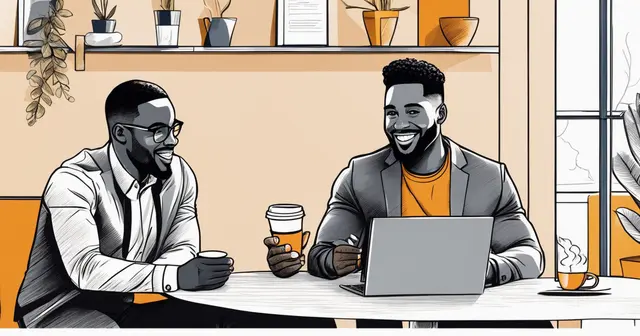7 Best Coffee Chat Tips in 2025
Table of contents
The Basics of a Successful Coffee Chat
The most important aspect of a coffee chat is having a clear objective or goal for the meeting.
Having a purposeful (virtual) coffee chat requires preparation and intention. Before suggesting a coffee chat, think about your goal and what you hope to gain from the meeting. Are you simply looking to build rapport and make a connection with someone, or do you have more specific objectives in mind? Some common goals for coffee chats include seeking career advice, gaining industry insights, building your professional network, exploring potential partnerships, pitching freelance projects, and more.
Regardless of your specific aim, clearly communicating your purpose upfront helps set proper expectations. When initially reaching out, briefly explain why you'd like to meet. This helps the other person understand how they can best assist you. During the actual chat, revisit your agenda and steer the conversation accordingly. With a defined goal guiding the discussion, you'll find the meeting much more meaningful and worthwhile for both parties.
Other keys for coffee chat success are showing genuine interest in the other individual, listening more than speaking, and respecting your contact's time constraints. Follow up within a day or two with a thank you note recapping any helpful insights, suggestions or next steps discussed. With intentionality and care, a coffee chat can lead to amazing professional opportunities. So approach them thoughtfully, and you may be surprised what doors they can open.
Tip #1: Do Your Homework

The most crucial preparation step is researching the person you'll be meeting with.
Before requesting a coffee chat, take time to learn about the individual's background, company, role, projects, interests and more. Sources like their LinkedIn profile, company website, published articles, social media feeds and mutual connections provide insight. Understanding their experience and perspective helps you determine how they can specifically help you. It also allows you to craft a more compelling outreach message explaining why you'd value meeting them.
During your research, identify any common ground between you, like shared alma maters, employers, interests or connections. Look for recent news involving their company or industry that could lead to natural conversation starters. You want to avoid basic questions that are easily found online. Thorough preparation demonstrates your genuine interest in the person as an individual, not just in how they can help you. It also enables more informed, engaging dialogue, as you'll be able to discuss topics and ideas tailored to them.
Don't let your homework go to waste! Come equipped with a few open-ended prompts drawn from your research to keep the conversation flowing naturally. The more individualized attention you put into getting to know the person beforehand, the more value you'll gain from your time together. Doing your homework helps transform a coffee chat from a generic meeting to a meaningful opportunity to establish rapport.
Tip #2: Listen Actively

The most important communication skill to practice is active listening by being fully present and engaged.
A coffee chat is meant to be a two-way dialogue, not a one-sided download of information. Make sure to balance speaking and listening. Give your full attention when the other person is talking. Maintain eye contact, nod to convey understanding, and avoid distractions like checking your phone.
Ask thoughtful follow-up questions to show you're interested in what they're saying. Paraphrase key points back to them to ensure you correctly understand their perspective and advice. Avoid interrupting or abruptly changing the topic - let the conversation flow naturally based on what you both have to say.
Active listening helps build rapport and trust. The person you're meeting with wants to feel heard and know their time and insights are valued. When you listen closely, you pick up subtle cues about their personality, communication style and priorities that shape the interaction. You'll gain more insightful information when the other person feels comfortable opening up.
Following up within a day or two to reiterate your appreciation and revisit any suggestions demonstrates you were truly paying attention, not just going through the motions. Making active listening a priority ensures you walk away with a meaningful connection, smarter perspective and actionable next steps to build upon. So stay focused in the moment, keep your ego in check, and remind yourself that you have two ears and one mouth for a reason during your next coffee chat.
Tip #3: Be Genuine and Authentic

The key is to have an open, honest dialogue where both people can be themselves.
A coffee chat is meant to be a low-pressure way to start building a connection, so bring your real, human self to the table. There's no need to put on an overly professional, stiff facade. Speak openly about your background, interests, challenges and goals. Ask thoughtful questions to better understand the other person's experiences.
Conversations flow best when you're authentic, not pretentious. Admit if there are certain topics or questions you're still figuring out. It's perfectly acceptable not to have all the answers. Chatting over coffee is about exploring ideas and gaining new perspectives, not impressing each other.
Don't just talk about yourself the whole time either. Make sure the other person has opportunities to speak. Actively listen and look for common ground you can bond over. Share personal anecdotes when relevant to show you’re genuinely engaged.
Bringing authenticity and humanity to the interaction builds trust and rapport. The other person will recognize and appreciate you taking a sincere, thoughtful approach. An open, two-way exchange of ideas is far more rewarding than a rigid interview-style interrogation. Shed the formalities, be your real self and see where the conversation leads you. The connections and insights gained when both people feel comfortable being genuine can lead to exciting further collaborations down the road.
Tip #4: Mind Your Body Language

Use open, welcoming body language to make your conversation partner feel comfortable.
Nonverbal cues can speak volumes, so be mindful of your posture, facial expressions, hand gestures and overall demeanor. Sit facing the other person with your shoulders relaxed and arms uncrossed, which conveys receptiveness. Lean in a bit and make frequent eye contact to demonstrate your attentiveness. Smile warmly and nod along as they’re speaking.
Avoid distracting mannerisms like fidgeting or foot tapping. Don’t let your gaze wander around the room or down at your phone, as this suggests disinterest. Keep your motions calm and understated. Give the other person space and don’t crowd into their personal zone.
Mirroring their body language can help build subconscious rapport. If they lean in when making a point, do the same. Adjust your energy level to theirs - if they speak animatedly, feel free to gesture more with your hands. Picking up on nonverbal cues helps you connect better.
Posture impacts your mindset, so sitting up straight will keep you focused. Take a cue from their speaking style and volume to modulate your own voice. Paying close attention to body language nuances takes practice, but it’s worth refining these skills. A relaxed, open demeanor combined with engaged, active listening will make your coffee chats more productive and enjoyable for everyone involved.
Tip #5: Keep the Conversation Balanced

Aim for an equal, two-way dialogue instead of a one-sided interrogation.
A coffee chat should feel like an open exchange of ideas between peers, not an interview. Make sure there's room for both people to ask questions, share insights and guide the discussion. Don't bombard the other person with a constant stream of questions without letting them speak.
Give them openings to steer the conversation and volunteer information they find relevant. Share personal perspectives and anecdotes to keep things balanced. If you notice yourself dominating the dialogue, pull back. Ask the other person open-ended questions like "What are your thoughts on that?" to graciously give them the floor.
Similarly, speak up if you have something to contribute but can’t get a word in. Say something like, “If I may add...” to introduce your viewpoint while remaining polite.
Reading body language helps clue you in if the other person looks eager to interject. Overall, aim for around a 50/50 split in speaking time so you both benefit.
An uneven, lopsided conversation often feels draining and unsatisfying. Maintaining balance and flow keeps the exchange lively and allows time to process insights between responses. Stay aware of sharing the airspace equally so the chat provides value for both parties. With some courteous give and take, you’ll establish a collaborative rapport that could lead to future mentorship, partnerships or mutually beneficial introductions.
Tip #6: Respect Time Constraints

Keep the meeting succinct and recognize when your contact has other commitments.
Most coffee chats last 30-45 minutes, so be considerate of your host’s limited time. Avoid meandering off topic or prattling on just to fill space. Ask if they need to end the meeting within a set timeframe. Give them opportunities to redirect the conversation if needed.
Have your key questions and talking points prioritized so you can cover the most important ground first. If they seem pressed for time, table any lower-priority items for follow-up emails or future meetings. End the chat gracefully if you notice signs of fatigue or distraction on their end.
When booking, clarify expectations for meeting length and location logistics. Arrive a few minutes early so you don’t need to cut things short. During your initial outreach, state you value their time and expertise and just want a brief introductory meeting.
Following up with appreciation for their time shows respect. Don’t linger long after you’ve covered the core topics, as they likely have a busy schedule. Leave them your contact information for any future questions.
Remember, this is an initial get-to-know-you meeting, not a day-long conference. Focus on building rapport and exchanging just enough information to gauge interest in connecting further. If there seems to be common ground, you can delve deeper in future interactions once you’ve established a relationship. With care for the other person’s schedule and obligations, you’ll make professional coffee chats productive and pleasant experiences.
Tip #7: Follow Up After the Chat

Send a thank you note recapping main points to continue the connection.
Always follow up within a day or two of your coffee chat. Email a sincere thank you for the person’s time and insights. Briefly summarize key takeaways and next steps discussed so you’re aligned. Share any helpful resources, articles or introductions they suggested.
Ask if you can stay in touch via email or LinkedIn as you work on action items from the meeting. Make it clear you appreciated their advice and are committed to ongoing collaboration. A prompt, thoughtful follow-up note strengthens your new relationship and keeps momentum going.
If there were specific critiques or constructive feedback, demonstrate you took them to heart and are working to improve. Loop back if you have any additional questions once you’ve had time to process the conversation.
Follow through on any promises or requests made during the meeting, and keep your contact posted on your progress. This shows you respect their input and value developing an ongoing mentorship-style connection.
Following up properly after an initial meeting is critical for nurturing professional relationships over time. Don’t just disappear and hope the person will remember you. Sending appreciation, asking thoughtful questions and reporting back on next steps makes a strong impression. With consistent, caring follow-through, a single coffee chat can blossom into a treasured career mentor and colleague.
Why networking coffee chats are important

Networking coffee chats provide an excellent opportunity to learn from experts in your field, create meaningful connections, gain valuable insights, and improve your social skills. In our increasingly digital world, sitting down for an in-person chat over coffee can be invaluable for growing your network and advancing your career.
First and foremost, coffee chats allow you to learn from someone with more experience in your industry. As you pick their brain, you gain priceless advice and lessons they've learned throughout their career journey. They can provide guidance on everything from breaking into the field and navigating office politics to achieving work-life balance and pursuing leadership roles. An expert's first-hand perspective helps you avoid common mistakes and forge your own successful path.
In addition, coffee meetings help you make meaningful connections in your field. Having a robust professional network boosts your visibility within the industry, exposes you to new opportunities, and provides critical support throughout your career. When you take the time to meet someone face-to-face, it fosters a deeper, more nuanced relationship and builds trust. The rapport created over coffee makes them much more likely to think of and recommend you for open positions.
Sitting down over coffee also lets you gain valuable insider insights you simply can't find anywhere else. Experts will often openly share advice, perspectives, and lessons learned in a more casual, one-on-one setting. The intimate coffee chat setting makes them more comfortable opening up. You can gain priceless institutional knowledge and industry context that gives you a leg up.
Finally, coffee meetings provide excellent practice for improving your social skills and conversational abilities. Making small talk, asking thoughtful questions, listening intently, and following up afterward are key skills for building relationships and getting ahead. The more coffee chats you do, the better you become at connecting authentically. This builds the confidence and poise needed to thrive.
In summary, taking the time to meet with industry experts and colleagues over coffee provides immense value for career development and growth. The face time leads to deeper connections, insightful advice, and improved social skills. Coffee chats are a low-pressure way to expand your horizons and get noticed. So don't underestimate the power of a perfectly brewed cup of coffee shared with the right person.
Best ways to reach out for a coffee chat

The best way to reach out for an informative coffee chat is to send a personalized LinkedIn message. Start by finding their profile, reviewing their experience, and identifying common connections. Then draft a brief, friendly invite that explains why you'd value meeting them. Mention any shared connections, companies, or interests to make it more personal.
LinkedIn message
Sending a message through LinkedIn's messaging system is often the most effective outreach method. LinkedIn profiles offer a wealth of information to personalize your invite. Review their experience and identify shared connections, alumni status, or groups. A personalized invite stands out from generic copy-and-paste messages.
Keep your message brief but specific. Introduce yourself, explain why you'd like to meet, and suggest meeting for coffee. Ask for 15-20 minutes of their time. Propose a few time slots that work with your schedule.
If you have mutual connections, mention them in your invite. For example, "Jane Smith suggested I reach out". Name dropping a shared connection adds legitimacy.
Email outreach
If you don't share LinkedIn connections, finding their business email address is the next best option. Keep your email concise yet thoughtful.
Briefly explain who you are, where you work, and why you'd value meeting them. Share just enough background to spark their interest and intrigue them to learn more in person.
Suggest meeting for a quick 20-minute coffee chat. Offer a few potential times and dates that work for you.
Twitter (X) DM
If you already have an existing Twitter relationship with someone, a DM can feel more personal than an email. Keep it casual, like you're talking to a friend.
Refresh their memory on how you met if it wasn't recent. Briefly share why you'd love to meet up and continue the conversation over coffee.
Ask for a short 15-20 minute chat. The low time commitment makes it easy to say yes.
Mutual connection intro
Leveraging a mutual connection can get your foot in the door, especially if they provide a warm introduction.
Ask your shared connection for an email intro or LinkedIn recommendation. This gives you instant credibility. In your outreach message, acknowledge the mutual connection and thank them for the intro.
Cold outreach
If no existing contact, a cold email or LinkedIn invite can still be effective. Keep it concise and explain how you came across their name. Share your background and why you'd value meeting them.
Articulate what you'd like to learn from them or ways you think you could collaborate. Provide value instead of just asking for something.
Follow up tactfully if they don't respond initially. Persistence pays off but don't badger them.
Reaching out for an informational interview or coffee chat is a thoughtful way to grow your network. With a personalized, value-focused approach, you can connect with influential professionals and have an engaging discussion.
Conclusion

Coffee chats are invaluable for growing your professional network, gaining insights and forming meaningful connections. With preparation and intention, you can maximize the value gained from any informational meeting. Do your homework beforehand to engage in informed dialogue tailored to the individual. Listen actively and balance speaking time to foster an equal exchange. Bring authenticity and mind your body language to build rapport. Keep the conversation focused and respect time limits. Follow up promptly to continue building the relationship.
Approaching coffee chats with care and strategy elevates them from generic small talk to productive interactions. The ideas sparked and relationships forged over coffee have tremendous potential. An hour spent genuinely connecting with the right person at the right stage of your career can be career-changing.
So be purposeful, but also open to unexpected twists and turns. With a thoughtful, attentive approach, coffee chats unlock amazing possibilities. Use these tips to make the most of professional networking meetings. Turn casual coffee breaks into valuable opportunities to learn and grow. The insights gained will stick with you long after the cups are empty.